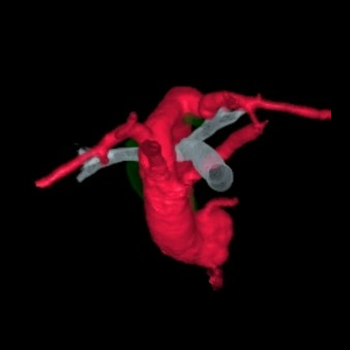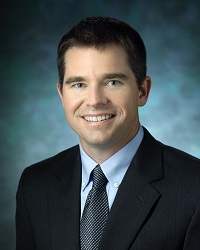Overview
Vascular ring is a congenital anomaly where the aorta and surrounding blood vessels develop abnormally, forming a ring-like structure that encircles the trachea and esophagus. A vascular ring can lead to breathing and swallowing difficulties as well as heart problems. Rady Children’s Hospital in San Diego specializes in the treatment of vascular rings, offering various surgical and non-surgical options under the leadership of Matthew Brigger, MD, chief of the Division of Otolaryngology, and John Nigro, MD, chief of the Division of Cardiac Surgery and Director of the Heart Institute.
Pediatric Aerodigestive Vascular Ring Program at Rady Children’s Hospital

Sage received world-class care from our Otolaryngology team at Rady Children’s Hospital. Read the Story.
Rady Children’s Hospital provides a comprehensive tailored approach for each patient through our Aerodigestive Vascular Ring Program. A multidisciplinary team of experts from otolaryngology (ENT), pulmonary, gastroenterology, cardiology, speech-language pathology, occupational therapy, and nutrition will assess your child. The team of medical professionals conduct a detailed history and examination, utilizes advanced imaging and diagnostic tests, and develops an individualized treatment plan based on your children’s evaluation. Additional tests for patients may include a Triple endoscopy, CT imaging, Pulmonary Function Testing, and swallow studies. After our thorough assessment, a 3D model is created of your child’s vascular ring. Depending on the severity of your child’s symptoms, we may discuss your child’s vascular ring at our monthly conference which includes specialists from the Aerodigestive team, Cardiovascular Surgery, Radiology, and a 3D printing scientist. This comprehensive team approach allows our team to give your child the best-individualized care possible. We continue to manage your child’s care long after any surgery is performed and work with you to create long-standing success.
What Is a Vascular Ring?

A vascular ring occurs when the aorta and its branching blood vessels are improperly formed, causing compression of the trachea and esophagus. Vascular rings occur in approximately 1 in 2,500 births, with a higher prevalence in boys. Vascular rings are usually isolated, but can also happen with other congenital heart defects. Some patients may have associated with genetic conditions, the most common of which is 22q11 deletion syndrome (aka DiGeorge syndrome).
There are two common types of vascular rings
- Double aortic arch: It happens when there are two separate aortic arches, one on the right and one on the left. The two arches wrap around each side of the trachea and esophagus.
- Right aortic arch with aberrant left subclavian artery: This type of vascular ring happens when the aortic arch is on the right side of the chest, but the left subclavian artery comes out of the aorta from behind and is attached by a left-sided ligament that surrounds the trachea and esophagus, potentially squeezing them.
Symptoms & Diagnosis
A child may or may not have symptoms depending on how tight the vascular ring is around the trachea and esophagus. Some children and adults may have no symptoms of heart problems at all. Other children may have symptoms due to the airway or esophagus being compressed by the vascular ring.
Some common symptoms of patients include:
- Noisy breathing (may have a high-pitched sound when breathing in called stridor)
- Difficulty breathing
- Frequent respiratory infections with prolonged recovery
- Chronic cough
- Difficulty swallowing foods
- Poor feeding and/or frequent vomiting
A vascular ring may be suspected by your medical professor during an exam, based on symptoms or a chest x-ray. Vascular rings can be diagnosed on an echocardiogram (heart ultrasound) when your child is in utero or after birth; if the vascular ring is suspected in utero, you may meet with our Fetal Cardiology team of health care professionals to discuss how this may affect maternal pregnancy and delivery plans. Your provider may also recommend more detailed imaging of the vascular ring, such as a CT scan or MRI of the chest and/or heart, which can look at the abnormal blood vessels as well as the airway and esophagus.
Treatment and Management
At Rady Children’s Hospital, all of our medical professionals believe that not all vascular rings need surgical repair, especially if a child is without symptoms.
For children experiencing symptoms, the primary treatment for vascular ring is surgery. Surgery is typically successful, and most children recover fully. The goal of surgery is to remove the abnormal ring of blood vessels that is compressing the trachea and esophagus.
If surgery is recommended, the cardiovascular surgeon will decide the best approach to the repair after reviewing all the imaging. The two different approaches may be either: A) accessing the chest wall on the side between the ribs (called a thoracotomy), or B) dividing the breastbone (sternum) to access the chest cavity (called a sternotomy). Once the vascular ring is reached, techniques to resect may include takedown of vessels or ligaments that create the vascular ring, re-implanting the abnormal subclavian artery, and/or re-positioning the aorta.
After your child’s surgery, health care professionals continue to manage your child’s care through our outpatient clinic to ensure your child’s breathing and feeding are improving for optimal success.
Matthew Brigger, MD, Division Chief of Otolaryngology
 Dr. Matthew Brigger is a medical professional and is the chief of the Division of Otolaryngology at Rady Children’s Hospital-San Diego and a professor of surgery at UC San Diego School of Medicine. Dr. Brigger’s clinical interests focus on diseases of the upper aerodigestive tract, with a particular focus on surgical management of breathing and swallowing disorders in children.
Dr. Matthew Brigger is a medical professional and is the chief of the Division of Otolaryngology at Rady Children’s Hospital-San Diego and a professor of surgery at UC San Diego School of Medicine. Dr. Brigger’s clinical interests focus on diseases of the upper aerodigestive tract, with a particular focus on surgical management of breathing and swallowing disorders in children.
Dr. Brigger is a pioneer of the Pediatric Aerodigestive Vascular Ring Program at Rady Children’s Hospital with the goal of providing comprehensive and accessible care to children with this ailment.
Contact Us
Pediatric Aerodigestive Vascular Ring Program
Rady Children’s Hospital
Otolaryngology Clinic
Medical Office Building 1st floor
3030 Children’s Way
San Diego, CA 92123
Tel: (858) 966-1700 ext 223403
Fax: (858)-966-4062
Email:RadyAerodigestive@rchsd.org